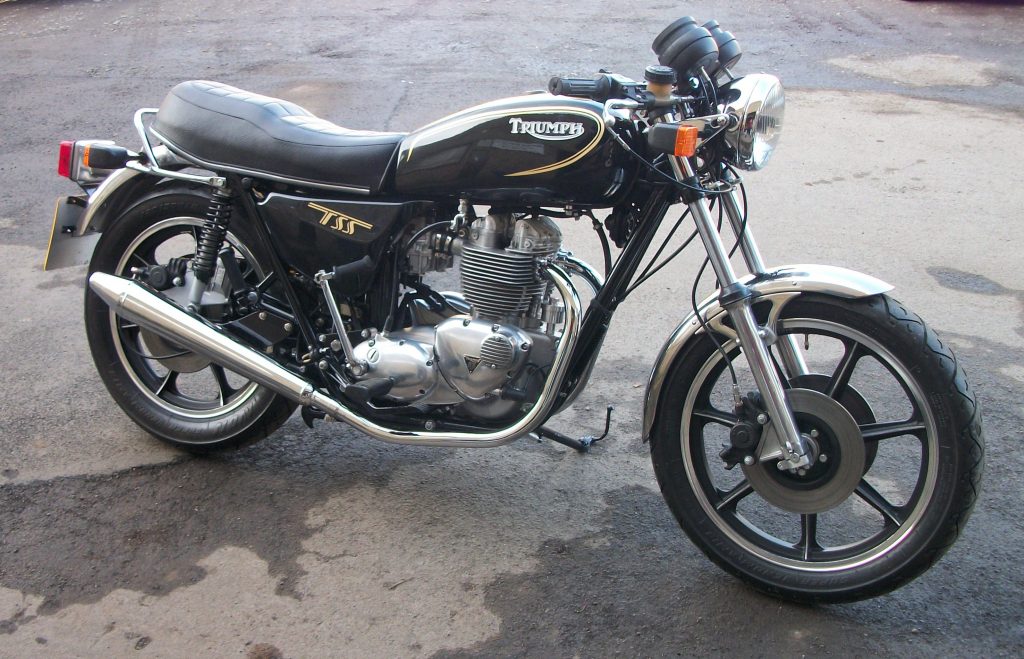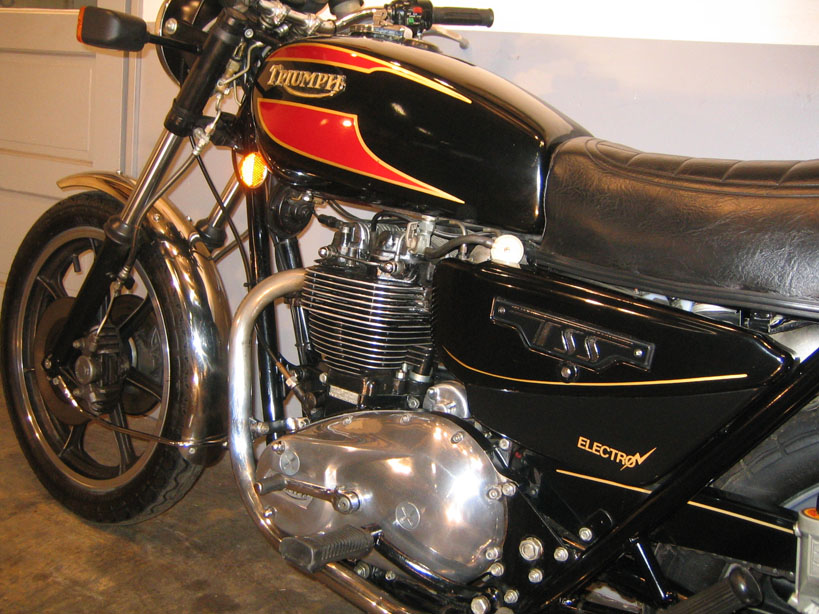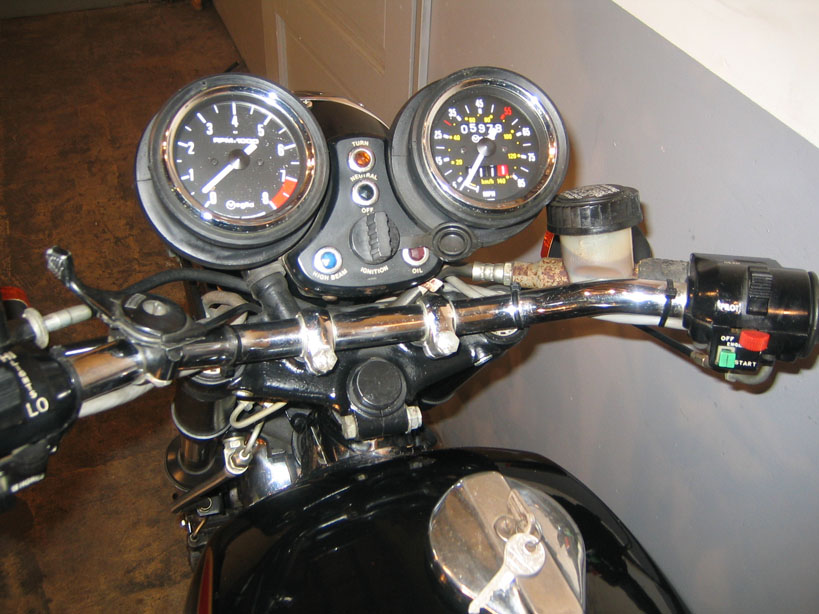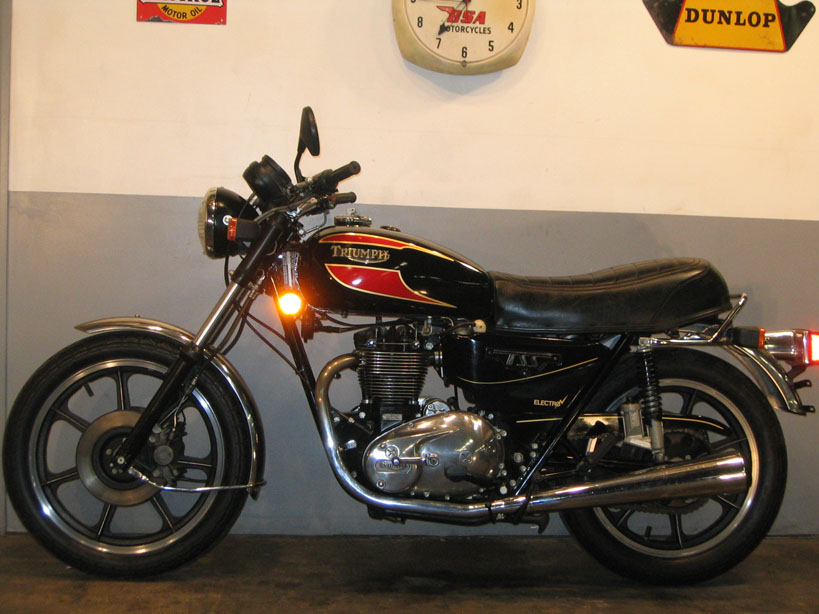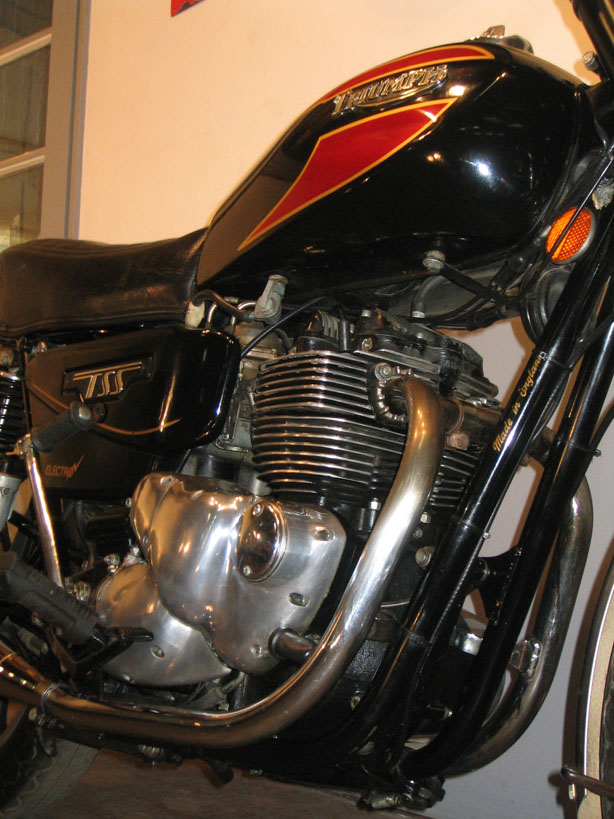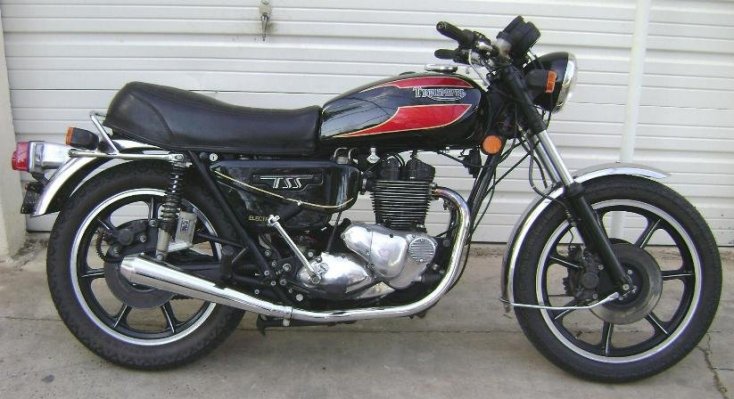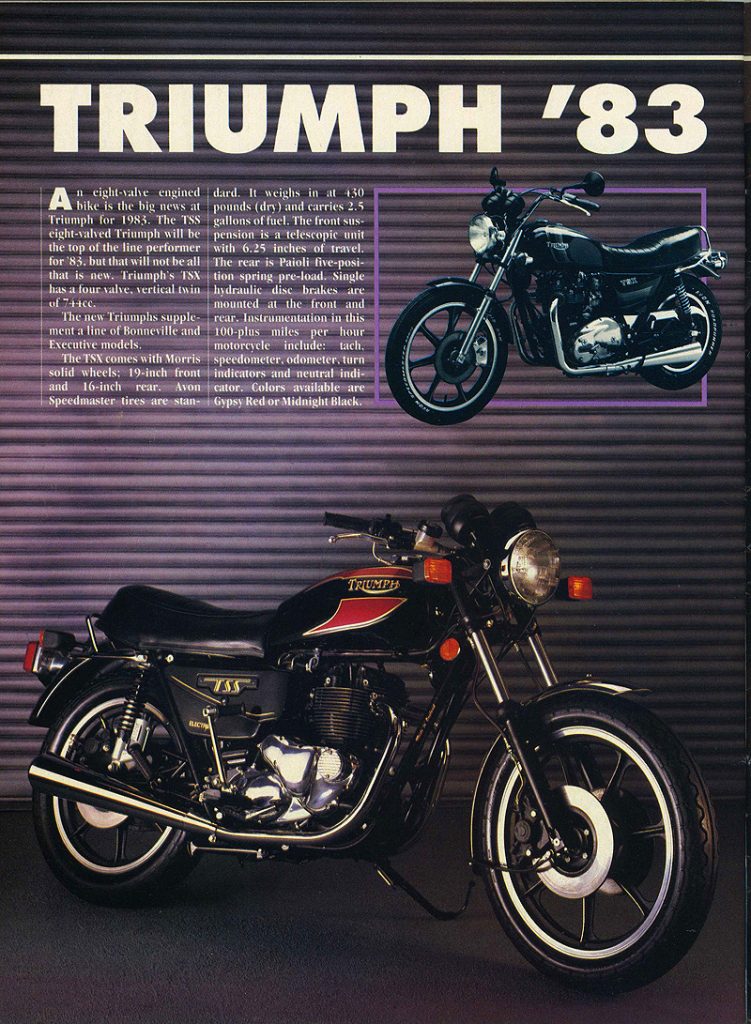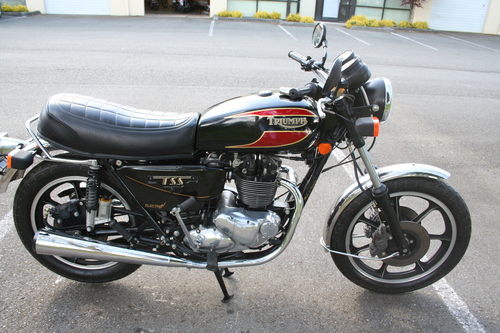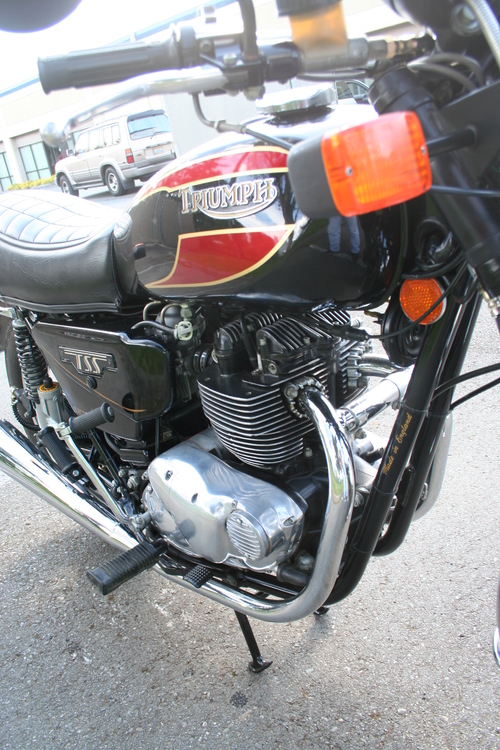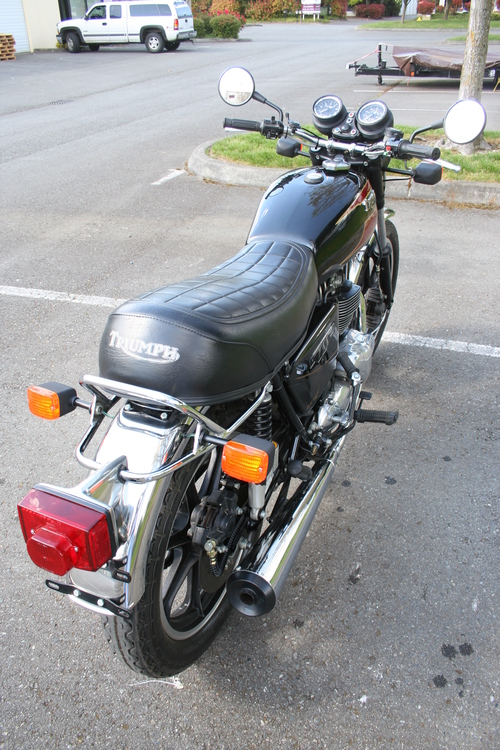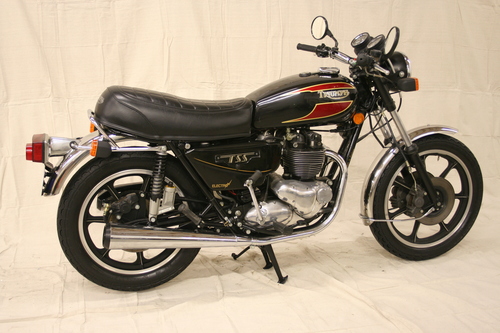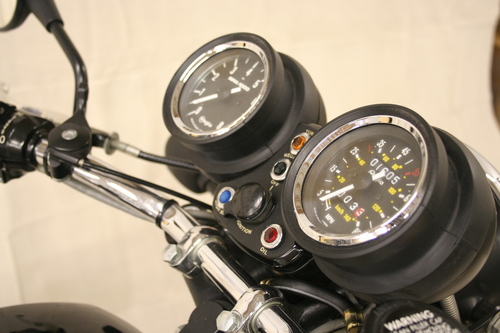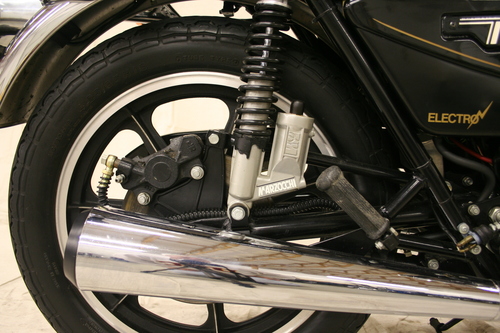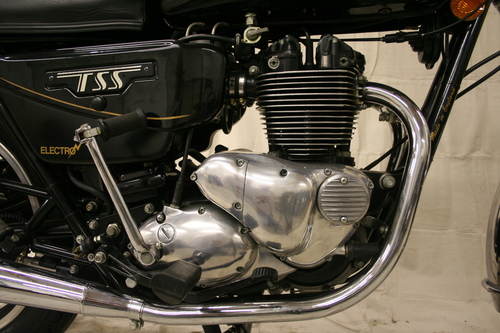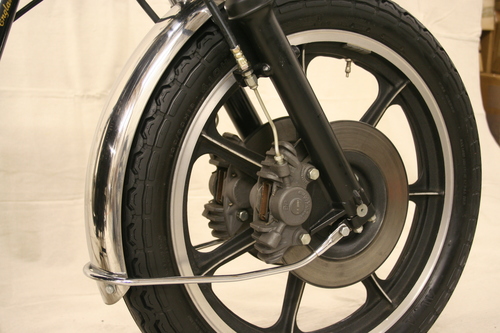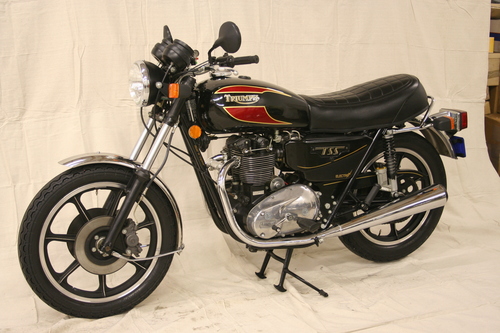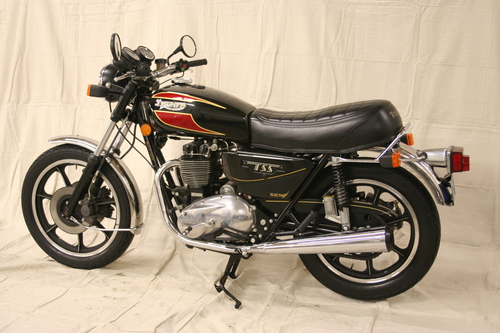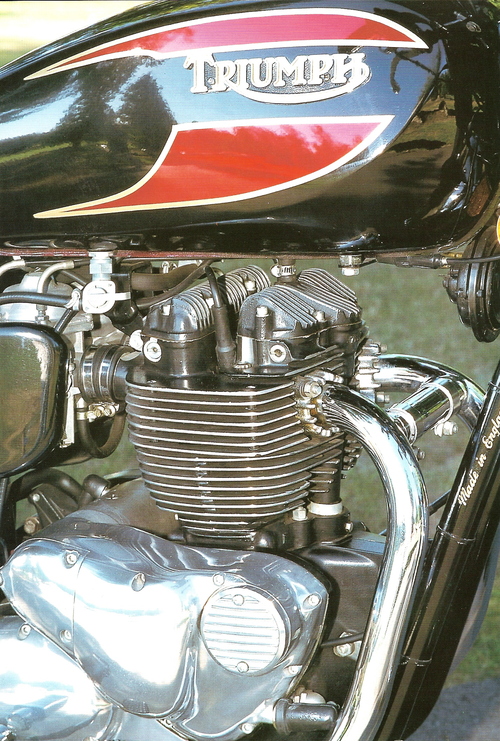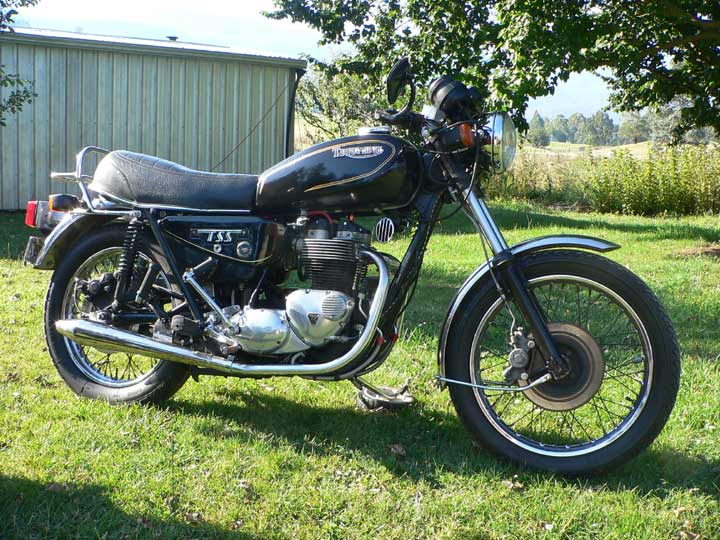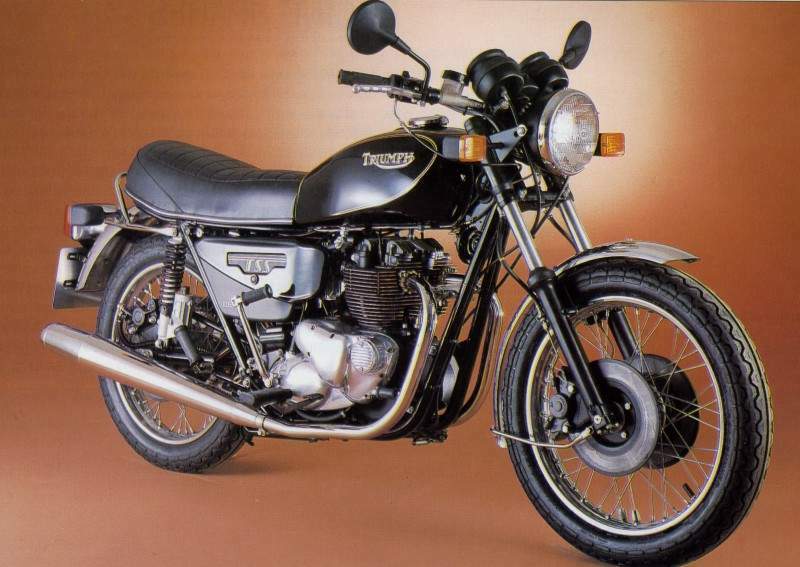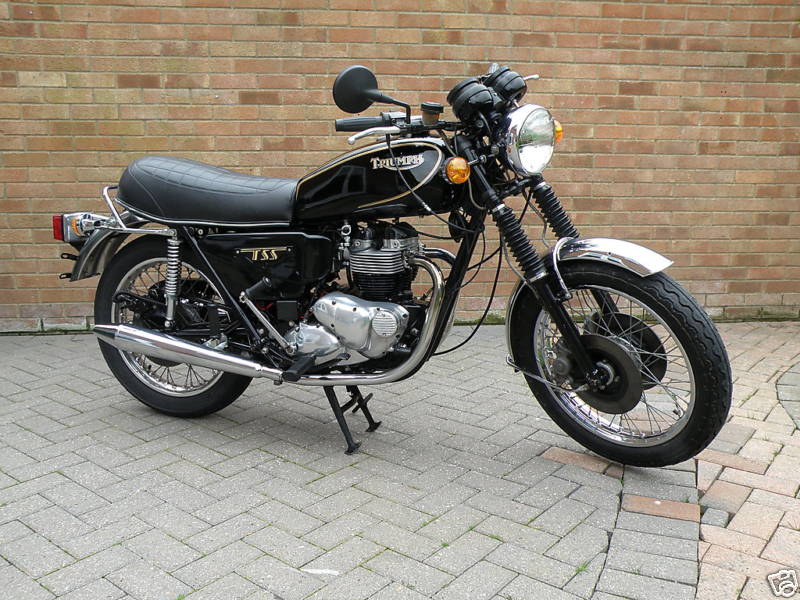Présentation de la Triumph TSS
Période de fabrication : 1982 – 1983
Historique : La TSS (T140TSS) représente la dernière tentative de Triumph de résister et riposter aux machines toujours plus puissantes, notamment en provenance du Japon, avec un modèle compétitif et sportif.
Avec une pointe à 195 Km/h, la TSS est en fait, avec la Trident 750, la plus rapide des routières construites par Triumph jusqu’à cette date.
La Bonneville TSS millésime 1983 fera partie des toutes dernières motos à sortir des usines Triumph de Meriden et restera jusqu’à sa renaissance dans les années 2000 la version la plus aboutie du roadster britannique.
La coopérative de Meriden disparaîtra peu de temps après le début de la mise sur le marché de la TSS qui ne sera produite qu’à 438 exemplaires, pour seulement 31 à destination du marché français.
Galerie Photos Triumph TSS
Caractéristiques Techniques
Moteur
Type : bicylindre vertical calé à 360° refroidi par air
Distribution : Culbutée à 4 soupapes
Cylindrée : 744 cm3
Alésage x Course : 76 X 82 mm
Taux de compression : 9,5:1
Alimentation: 2 carburateurs Amal de 34 mm
Puissance : 58 ch à 6500 tr/mn
Avance à l’allumage : 30° contre 38° pour la T140
Démarreur : électrique
Transmission
Embrayage : multidisques dans carter humide
Boite de vitesse : 5 rapports
Transmission finale : Chaîne
Partie-cycle
Jante avant : Morris 19 pouces
Jante Arrière: Morris 18 pouces
Amortisseurs arrières : Marzocchi Strada
Disques avant : Doubles étriers Lookeed de 254 mm
Disques arrière : simple étrier Lookeed de 254 mm
Divers
Hauteur de selle : 775 mm
Réservoir : 18,2 litres
Poids : 186,1 kg
Article paru dans MCN en 1982 :
« TRIUMPH’S technical men would cringe if they heard you call it an eight valve Bonneville. And it’s a fact that their 750cc TSS is more than the old Bonnie with extra holes in its head. Beneath the black paint on the big twin engine lie some designs which boost power by a dramatic 20 per cent and cut vibration.
The result is a Triumph with bags of mid-range grunt yet with a smooth willingness to rev. In fact, it was so smooth running, I thought it had an anti-vibration frame!
In line with my policy to thrash it first and ask questions later, I took my first run at the MIRA proving ground without looking for those rubber engine mountings. Only familiar tingles at the top of the rev range were a give-away that this was a standard chassis.
Almost uncanny engine smoothness (by Triumph standards) up to around 5,500rpm has been achieved on the TSS from simply beefing up the crankshaft.
The Meriden factory’s new development chief Martyn Roberts said the source of much vibration from the parallel twin had been traced to flex in the crankshaft.
To cure this, they have stiffened it by leaving a lot more metal on the shaft. This means the big end bearings are of a larger diameter, yet are narrower. They have the same surface area to take the load. Conventional main bearings are used.
As a result of the narrower big ends, the crank webs are wider – and they are now machined so there is no chance of accidental imbalance in the castings.
Beefier connecting rods push through new aluminium alloy barrels. Moving from steel to alloy has resulted in an eight pound weight saving.
At the heart of the Triumph’s performance boost is the Weslake-made cylinder head.
Four valves per cylinder mean better gas flow and a more efficient combustion chamber design can be used.
In the old style head, the size of the two big valves meant the combustion chamber had to be domed (hemispherical) and the spark plug placed on one side.
To bring compression up to an efficient level, the piston had to have a domed top.
Four valves change the whole set-up. This enables valve angles to be more upright, the spark plug centrally placed and the chamber less domed. The pistons are now flat topped, with cut-always for valve clearance and as a result are lighter than before.
Moving the plug has a big effect-the flame path after ignition is shorter and more efficient. Ignition timing has been retarded from 38 degrees to 30 degrees before top dead centre — and now there is no chance of « pinking » or denonation.
Combustion of that expensive mixture is now so good that a compression ratio of 9.5:1 has been adopted. And it looks likely that, after more testing, Triumph will approve use of two-star instead of four-star petrol.
Each pair of valves are opened by a forked rocker, being nudged by a single push rod, similar to the set-up in Honda’s CX500. Rocker shafts now run in the head casting and not in separate bolt-on units.
In looking for suitable cam profiles, Triumph have reverted to designs used for the T1 50 Trident. These are a lot less wild than the « Spitfire » profile used on the Bonneville inlet side, yet hotter than the Bonnie exhaust profile. « There’s a lot of scope for tuning yet, » said Martyn Roberts. « Getting speed out of the engine was no problem but getting an honest 58bhp from the eight valve engine-measured at the gearbox – while the standard Bonnie would deliver around 48. That’s a 20 per cent increase. » The torque curve is not a lot different to a Bonnie, but it retains its pulling power for longer.
Feeding the engine’s increased appetite for petrol and air-the throat area is increased by about 10 percent on the exhaust and about 20 per cent at the inlet- are a pair of 34mm Amal concentric carbs,compared to the standard 30mm Amals. Despite this tuning for power, Triumph engineers have been careful not to give extra performance at the expense of petrol economy. It was their aim to give riders an extra 10mph over the standard 110mph Bonnie, yet keep 50mpg within reach.
They certainly succeeded in their first aim-forthe TSS tripped the MIRA timing lights at top whack of 124.14mph with a following wind. Acceleration has been improved to match, with the old Bonnie’s time of 14.4 seconds through the quarter mile chopped to 12.94, and a terminal speed up from just over 90 to 102mph.
Triumph say they have recorded an amazing 1 26mph using a loose engine! But it’s interesting to see the Triumph’s 1 24mph compared to the 123mph MCN had from a 750 Norton Commando. Progress!
We have had to base our speed figures on results from Triumph’s own testing at the MIRA proving ground. Our test session was rained off! But one of our staff men witnessed a 122mph top speed run – so 124mph with a following wind seems about right. Not that Triumphs have been sold on promises of performance – at least, not since the Bonneville’s 100mph Isle of Man lap . . . but that was too long ago and before Triumphs were strangled by noise regulations.
The greatthing about the eight valve risth at it offers the kind of performance a good 650 would deliver back in the golden era of the 1960s. Most impressive was the roll-on acceleration in top gear from as low as 40mph. No hesitation as it surged forward, making down-changes unnecessary as it rumbled past mobile chicanes on the road.
Top gear flexibility was almost too good. Who would expect an eight valve machine with such a sporty nature to pull from 30mph in top? Buzzing through the gears to 5,000rpm gave 30, 40, 55, 65 and 75mph. It was a good point to change up, since vibration started to make itself felt from 5,500rpm. It’s great mid-range pulling power-where the only sign of vibration was a slight shaking through the rubber-mounted ‘bars at 4,000 to 4,200rpm was rather spoilt by the feeling that it was too low geared. That’s despite the fact the rearsprocket has 43 teeth compared to the standard Bonnie’s 45. I reckon it could pull a much higher gear-an the bonus here would be that the high rpm vibes would be pushed beyond reach.
As it is, a stretch of open road proved all too tempting and the needles swung towards illegal speeds all too often. Going faster than usual Bonnie speeds emphasised the drawbacks of Triumph’s traditional feet-forward riding position – 90mph speeds definitely require a rider to lean into the wind! The TSS is in its element on twisting A roads, when it would pull smoothly out of a corner no matter what gear was used, and rapidly head for the next apex with a pleasing four-stroke rumble.
Even with that extra power, the standard Triumph frame was more than a match for performance. No traces of bad manners as it flicked through the bends —either solo or two-up. Rubber mounted footrests – introduced with the new style four gallon tank — stay off the tarmac in all but extreme cases of lean and let the Avon Roadrunners stick to the chosen line. Those tyres seem ideal for the bike – and even in the wet gave plenty of warning that grip was running out. Add a pair of cast iron discs at the front, clamped by a pair of Lockheed calipers and braking ability – like the handling – is more than a match for road speed.
Those discs were powerful without losing sensitivity and are a standard fitting. It was easy to make the front tyre squeel in the dry and in the wet there was no cause for concern because a set of Dunlop wet weather pads are used. Standard Triumph front forks are used, but at the back are a pair of Marzocchi Strada suspension units. These employ gas and oil for damping and give a progressive effect -getting firmer as they compress. This meant the suspension wouldn’t bottom out even two-up with the spring pre-load set soft. A 60 watt halogen main beam gave an excellent spread of light at night – at the expense of penetration. But it’s quite up to matching night-time performance.
All this adds up to a bike which cries out to be ridden energetically. Yet, even when it’s on song through the back roads, it’s safe because the suspension and brakes can handle what you give it. Despite some enthusiastic riding, I could rely on 47mpg. Topping 50 should have been no problem, but squirting it around was simply too tempting. While Triumph engineers were giving the 750 a complete updating, they didn’t miss out the details. Like dog-leg clutch and brake levers to make them easier to use, a lightened clutch operation, and an uprated Lucas electronic ignition. There’s even a new seal on the petrol filler cap.
The eight valve head doesn’t mean home-maintenance is a thing of the past-there are just twice as many tappets to adjust. Ignition is pre-set. Details like angled grease nipples on the swinging arm bearings make life easier. It’s still a bike for the British iron enthusiast who likes to do his own maintenance. There are few criticisms but it was a bit reluctant to warm up on choke without stalling (the choke lever is now on the handlebars), the mirrors should have been wider set, and the rear grab rail was rather too low.
The bottom line reads£2,399-or£363 on top of an electric start twin-disc Bonnie. That cash buys a bike which feels like a thoroughbred. It’s been updated, not by fancy gimmicks, but with some well proven, solid engineering. It could be argued that it’s the best bike to roll out of Meriden. It could certainly by a British classic. TS. »
Si vous souhaitez ajouter des images ou des informations sur cette page, n’hésitez pas à m’envoyer un email (webmaster@triumphadonf.com) ou à laisser un commentaire ci-dessous.

